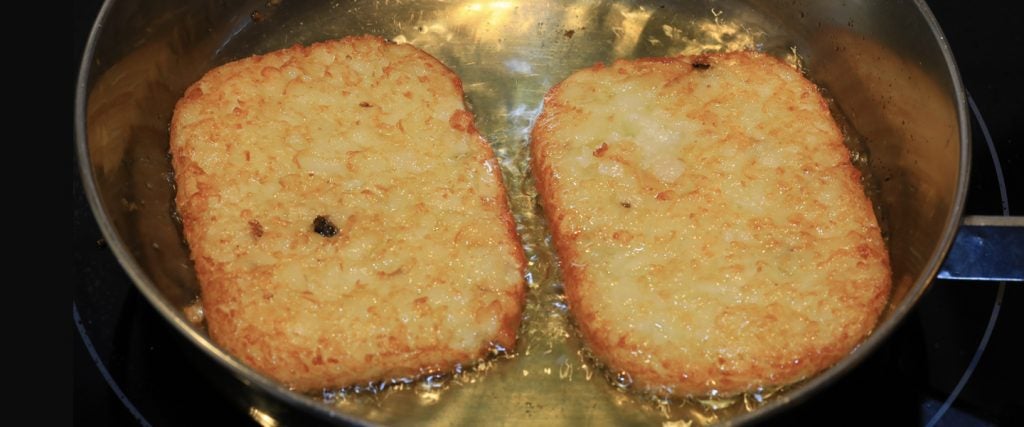Before I began dating my wife, a career dietitian who somehow remains perpetually McNugget-obsessed, I managed to last an entire decade without ever ordering a hamburger, McMuffin or any other item from McDonald’s that’s served encased between two pieces of bread. If someone successfully managed to drag me past the golden arches and through the front door of Mickey D’s for any reason, I’d limit my order to either a side of french fries, or if this pit stop happened to take place in the early morning, I’d score an order of hash browns.
No, I wasn’t under any illusions that what I was eating was healthy. I’d long since given up hope that anything outside of a McDonald’s salad could be healthy, and even then, we were talking about food items that were “healthy” only by way of comparison. But there was something innately appealing about the crisp crackle of a hash brown that left me feeling like I’d psychologically eaten something of nutritional value, even if all I was actually consuming was the glorified equivalent of a heated, unbagged potato chip.
Can’t hash browns or potato hash ever be healthy?
Man, I’d love to think so. But instead of wishful thinking, let’s do some investigating.
Here are the ingredients in a McDonald’s hash brown: Potatoes, vegetable oil (canola Oil, soybean oil, hydrogenated soybean oil, natural beef flavor, salt, corn flour, dehydrated potato, dextrose, sodium acid pyrophosphate (maintain color), extractives of black pepper.
Hmmmm… that’s a surprising amount of beef flavoring for a potato product. I’m also left wondering why additional dehydrated potato needs to be added to the ordinary potatoes that serve as the foundation of these hash browns.
From a nutrition standpoint, 140 calories is a more-than-acceptable total for a fast-food side item, especially if you can succeed in purchasing only one. If you decide to double-up or triple-up on the hash brown orders, that’s when your order begins to rapidly creep into french-fry territory.
Okay, but that’s a fast-food hash brown. Can ordinary hash browns be prepared in a healthy manner?
Before we go there, it’s probably worth going over a little hash-brown history first.
The recipe for “hashed brown potatoes” or “hashed and brown potatoes” began showing up in U.S. newspapers in the mid-1880s. By 1888, it appears to have been standardized that hash browns consisted of shredded potatoes that had been boiled, allowed to cool and subsequently fried before serving.
Apparently, though, some people believed this newfangled practice of frying shredded pieces of boiled potatoes bordered on witchcraft. A report from Nebraska’s Neligh News from January 1888 disclosed how Mrs. Rorer of New England lectured during a Health and Food Exhibition in New Haven, Connecticut about how the serving of hash browns spelled “dire disaster”: “She had visited insane asylums, she said, and found that many of the inmates had been addicted to the use of potatoes fried after boiling. Ergo, potatoes cooked in this way appear to produce insanity.”
All 19th-century potato paranoia aside, in terms of a nutritional breakdown, a raw potato — i.e., the variety filled with vitamin C, along with respectable quantities of potassium and vitamin B — is theoretically the most healthy version of the vegetable. Once you boil a potato, many of its water-soluble vitamins leach out into the water, including its vitamin B, vitamin C and much of its potassium. None of this gets any better after you fry it.
As such, what’s left behind is a micronutrient-depleted carbohydrate. It’s not the worst thing in the world if you’re searching for calories to sustain yourself, but it’s certainly no bag of baby carrots.
So, are hash browns healthy or not?
They aren’t unhealthy, but they aren’t close to being the optimal way to prepare a potato if you’re hoping to maximize its vitamin and mineral content. Again, the instant you boil a potato — whether you provide it with a follow-up dip in the deep fryer or not — its micronutrient qualities pretty much disappear.
Is this the worst thing in the world? Not necessarily, and you needn’t feel guilty about making room for hash browns during your weekly trip to the local diner. But is it undeniably healthy? Not really.
Or to put it in more appropriate terms given the subject at hand, it’s far from a potayto, potahto kinda thing.

